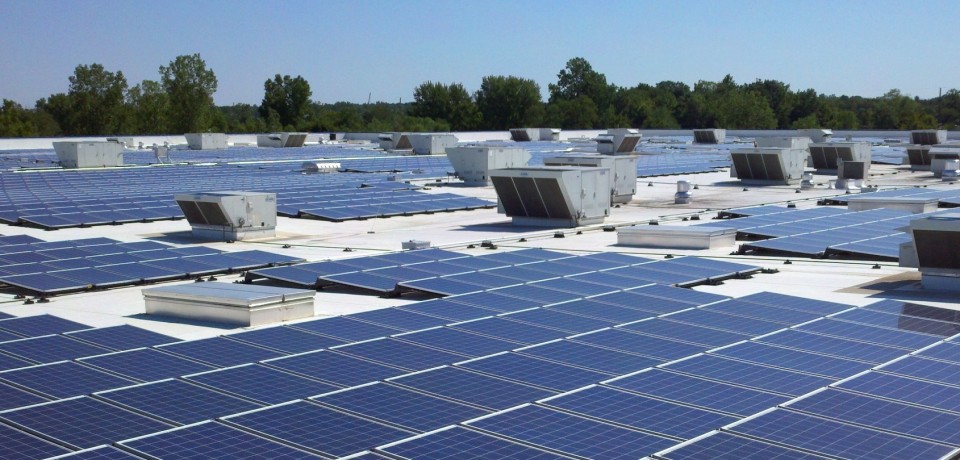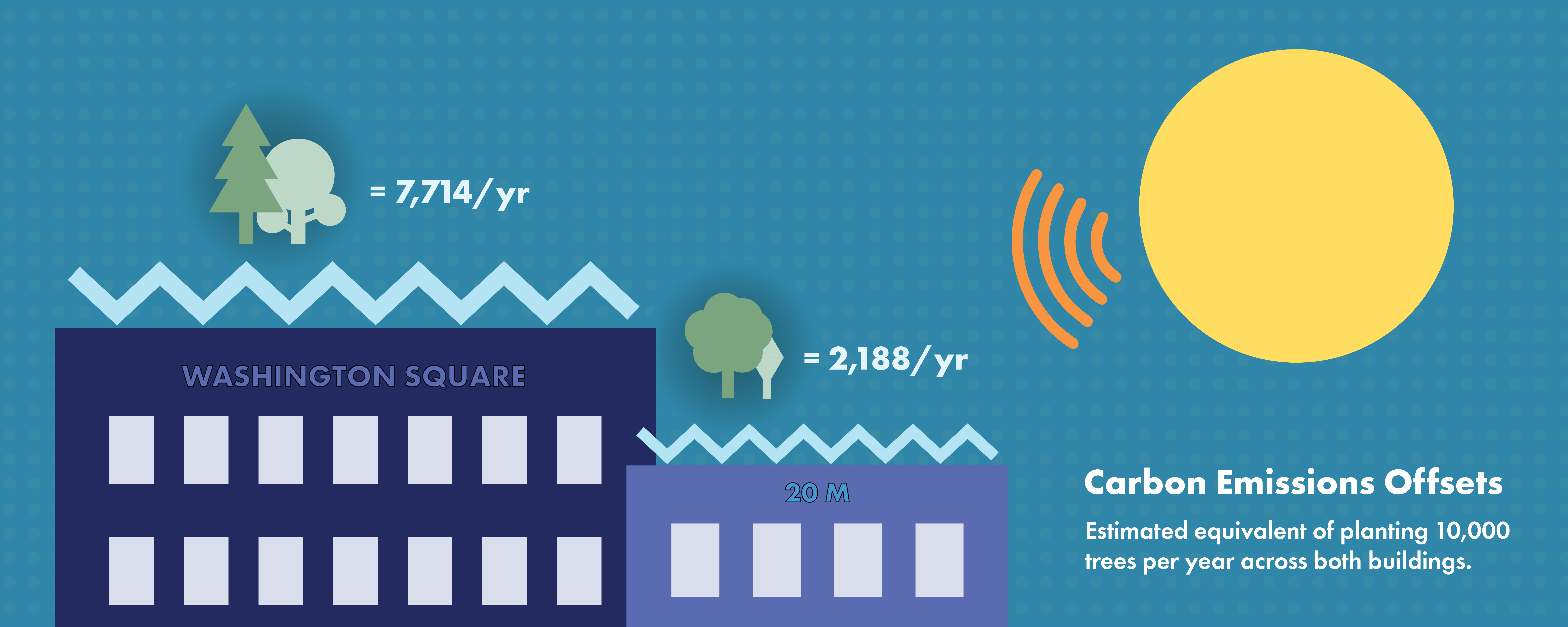In this case study, we will explore the decision-making process, coordination with stakeholders, benefits of adding solar, and challenges encountered.
Washington, DC has an ambitious renewable energy goal: make 50% of the District’s energy supply renewable by 2032. It will require a variety of measures to meet this goal, including the installation of solar panels on buildings in the District. Solar can reduce a company’s carbon footprint across its building portfolio, as well as save on annual energy costs. Lerner Corporation, a commercial real estate developer in the Washington, DC metropolitan area is contributing to that goal with the installation of solar PV panels on two of its commercial office buildings: Washington Square located at 1050 Connecticut Avenue NW and 20 M located at 20 M Street SE. The Hub interviewed Shawn Kyle, Lerner; Eugenia Gregorio, Gregorio Sustainability; and Mark Ballantine, Universal Renewables.
This resource is available courtesy of DCSEU.

Check out our solar energy guide for building owners.
Decision-making Process
Initially, Lerner evaluated contracting with a solar developer through a lease or power purchase agreement (PPA) as a way for someone else to pay for the upfront cost and on-going maintenance of the solar systems. Under both models, the solar system would be owned and operated by the solar developer and the building owner would benefit from either lease payments or, under a PPA, reduced price electricity. As Lerner learned more about tax incentives, solar renewable energy certificates (SRECs), and the opportunity for the system to be profitable, the team realized the business case for self-financing the system (also known as a direct ownership model). This option also fits better with their company structure and goals.
Lerner is a privately held real estate company so they were able to take advantage of certain tax incentives and the sale of SRECs to help make the business case for a direct ownership model, whereas other types of real estate companies, such as a REIT, may be better suited to working on a lease or PPA model with a solar developer.
Coordination with Stakeholders
Lerner engaged Gregorio Sustainability early in the decision-making process to understand the different on-site solar model options, financial benefits, and steps to consider. Founder and Principal of Gregorio Sustainability, Eugenia Gregorio, also prepared the RFP, identified potential engineering, procurement, and construction contractors (EPC) to engage, reviewed design proposals, helped manage the selection and contract process, developed the financial analyses, reviewed SREC options, and advised on the general project thru to interconnection.
Universal Renewables, a local DC Certified Business Enterprise (CBE), was selected to be the solar EPC to provide turnkey design and engineering, procurement, and installation services. Their unique system offering was instrumental in increasing solar capacity by elevating the panels above the rooftop equipment—a rooftop solar canopy system. Additional stakeholders included the Department of Buildings (formerly DCRA) for permitting, and PEPCO for utility interconnection.
PEPCO is a key stakeholder for any solar PV project that requires interconnection with the utility grid. Even when solar power generated is designed to be used by the building and not pushed into the grid, like this project through net energy metering (NEM), you still need permission from the utility. Depending on location and size, PEPCO determines whether additional controls are required to allow them the ability to control or shut down the solar PV system if it is impacting the surrounding utility grid. For Washington Square, telemetry monitoring and curtailment controls were Pepco requirements. The system is complicated, expensive, and required extensive coordination between the installer, Universal Renewables, and PEPCO.
Lerner’s senior management team was directly involved in all stages of the solar project. Their onsite property management and engineering teams helped with day-to-day project coordination and tenant communication during the construction phase. The property management and engineering team also coordinated closely with Universal Renewables for training and ongoing maintenance when the project was complete.
The project qualified for a rebate from the DC Sustainable Energy Utility (DCSEU), which helped reduce the payback period of the project investment. DCSEU also partnered with Lerner on other energy efficiency projects that has helped improve Washington Square’s ENERGY STAR score over time.
Project Description

Washington Square
- Address: 1050 Connecticut Avenue, NW, Washington, DC 20036
- Size: 720,000 sq. ft.
- Typology: Multi-tenant Commercial Office
- Constructed: 1982
- Certifications: LEED Gold, ENERGY STAR, Fitwel
- Solar System: 522 kW with 1290 Trina 410 W bifacial panels
- Annual Output: Over 650,000 kWh
- Online: February 2023

20 M
- Address: 20 M Street, SE, Washington, DC 20003
- Size: 190,000 sq. ft.
- Typology: Commercial Office
- Constructed: 2007
- Certifications: LEED Gold, Energy Star, Fitwel
- Solar System: 153kW with 374 Trina 410W bifacial panels
- Annual Output: Over 180,000 kWh
- Online: February 2023
Both solar projects used Universal Renewables’ locally manufactured aluminum canopy systems (pictured below), made from 80% recycled industrial aluminum, to raise the solar panels above the existing rooftop equipment on the main roofs and elevate them on the penthouse roofs.

This allowed both projects to nearly double the size, compared to the more traditional ballasted designs (pictured below) proposed by other EPCs who responded to the RFP. It’s important to note that canopy systems are more expensive than ballasted systems, but after doing research into this innovative design and doing thorough comparison of options—it was a great fit for the Lerner projects.

The projects are estimated to exceed design output due to the use of bifacial panels (pictured below), which generate solar power directly from the system, as well as reflected sunlight from the roof. Universal Renewables estimates that bifacial modules with elevated systems have the potential to increase production 5-6% compared to non-bifacial modules.

For Washington Square, the solar project is just one of nine projects completed in coordination with DCSEU. The other energy efficiency projects started being measured in 2018, before the BEPS standards were issued, and contributed to the building’s improved energy performance—bringing the ENERGY STAR score from 56 to 77, now meeting the Standard for its property type. As sustainability consultant Eugenia Gregorio of Gregorio Sustainability noted, “This solar installation is another project that may continue to positively impact their ENERGY STAR score, which should also help to meet building energy performance requirements.”
Benefits of Adding Solar

Adding solar has many benefits for Lerner’s buildings, including reduced operating costs. By relying on 650,000 kWh annually of solar production, Washington Square is able to offset approximately 5% of its energy usage with onsite clean energy. This will reduce Lerner’s electricity bills because they will use less kWh consumption from the utility grid. Further cost savings will be realized due to the reduced demand charges, which is another line item on the electricity bills.
There are also physical benefits of this particular installation where the solar PV panels are set on canopies above the rooftop equipment. These benefits include:
- providing additional protection and shade for the equipment
- allows for roof repairs, equipment replacements, and regular maintenance underneath the canopy
- solar power generation will not be interrupted by maintenance activities
The payback period for both of these projects is expected to be 4 years. The financial benefits that contribute to this payback period include electricity avoidance or operational energy savings from on-site solar generation, SREC sales, and tax incentive.
Benefits of solar extend beyond the building. Onsite solar generation offsets harmful scope 2 carbon emissions, contributing both to the company’s sustainability goals and the District’s climate commitments.
Challenges
Once Lerner decided to move forward with direct purchase of the solar panel system and selected Universal Renewables as the EPC—the engineering, permitting, and installation phases progressed relatively smoothly on both projects. The most significant challenge for both projects turned out to be the utility interconnection process. Utilities are a key player in meeting any jurisdiction’s carbon emissions reduction and climate goals, and proactive and well executed management of state and local solar programs are critical.
In DC, a solar project cannot go live without approval from PEPCO, and over the last few years the utility has faced criticism for solar program implementation. The Washington Square and 20 M projects were no exception and experienced lengthy delays due to PEPCO’s long lead times for each stage of the interconnection process. In this case, PEPCO required Universal Renewables to install system upgrades to protect the local grid, including reverse power relay schemes and telemetry monitoring devices. These upgrades required PEPCO’s approval of relay designs, delivery of programing data, and equipment testing. The relay systems and telemetry devices were designed, installed, and programmed by Universal Renewables under PEPCO’s guidance, with approval to operate coming after a series of tests conducted by PEPCO. While the PV systems were installed and inspected by summer 2022, final testing and approvals to operate were not completed by PEPCO until February 2023.
Lessons Learned
Buildings need to become more efficient as well as rely on clean renewable energy to meet the District’s carbon reduction and climate goals. To ensure a solar project improves building performance and supports BEPS compliance along with climate mitigation strategies, consider the following:
- Explore different contract and design options with your sustainability consultant and EPC to determine the best fit for your company and building.
- Consider a direct ownership model vs a lease or PPA contract structure with the selected EPC/solar developer. There are pros and cons, and the decision will ultimately depend on company structures and objectives for the solar project.
- Take a proactive approach to establish/document protocols and milestones with your utility to ensure expectations are clear and minimize delays.
- Build in time for coordinating with your local utility provider on developing testing procedures, if controls are required.
- Monitor SREC market and try to select best timing for locking rates, based on anticipated project completion.
- Collaborate with your public utility commission, solar advocates, and local departments of energy to ensure your utility provides timely service.
- Factor in comprehensive energy conservation measures to ensure your building meets BEPS.

About the Author
Mary Thomas is Associate Director for the Building Innovation Hub, helping the local building community design, build, retrofit, and operate high-performing buildings in and around Washington, DC. Prior to joining the Hub, Mary spent 15 years in the commercial real estate industry in Washington, DC, managing construction projects for Hines, a global real estate developer, and Clark Construction. Mary has in-depth experience across a broad range of project types in the DC area, including residential, office, site civil, and mixed-use development. She has a background in visual and environmental studies, earning a BA from Harvard, and she has been an accredited LEED AP BD+C since 2008.
Is your building our next case study?
If you have implemented an innovative efficiency solution, overcome challenges with compliance, or achieved a climate milestone—please reach out so we can continue learning from our industry peers.

